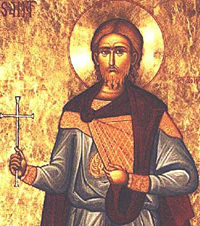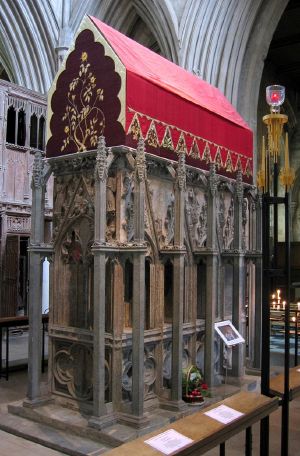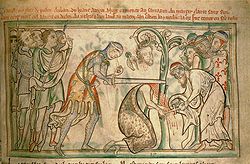Saint Alban
| Saint Alban | |
|---|---|
Saint Alban | |
| Martyr | |
| Born | unknown in Verulamium |
| Died | disputed: 22 June 209, c.251 or 304 in Holywell Hill (formerly Holmhurst Hill), St Albans |
| Venerated in | Roman Catholic Church; Anglican Communion; Eastern Orthodox Church |
| Major shrine | Cathedral and Abbey Church of St Alban |
| Feast | 22 June |
| Attributes | Soldier with a very large cross and a sword; decapitated, with his head in a holly bush and the eyes of his executioner dropping out |
| Patronage | converts, refugees, torture victims |
Saint Alban was the first known Christian martyr of Britain, who died c. 304 C.E. when he allowed himself to be mistaken for a priest to whom he had offered hospitality during a persecution. Along with his fellow saints Julius and Aaron, Alban is one of three martyrs remembered from Roman Britain.
Alban is listed in the Church of England calendar for 22 June and he continues to be venerated in the Anglican, Catholic, and Orthodox Communions. St Alban is mentioned in "Acta Martyrum," and also by Constantius of Lyon in his Life of St Germanus of Auxerre, written about 480. He also appears in Gildas' 6th century polemic De Excidio Britanniae.
In 2006 some Church of England clergy suggested that Alban should replace St George as the patron saint of England. There have also been claims that he should be patron saint of Britain as a whole.
Life
According to Bede's Ecclesiastical History of the English People, I.vii and xviii, Alban was a pagan living at Verulamium (now St Albans). He offered shelter to a priest who was fleeing from persecution and was consequently converted to Christianity and received baptism. Later on, when the governor's emissaries came to search the house, Alban disguised himself in the cloak of his guest and gave himself up in his place. He was dragged before the judge, and scourged, but refused to deny his new-found faith.
Condemned to death by beheading, on the way to the place of execution Alban is said to have miraculously stopped the course of a river so that he and his executioners crossed dry-shod. He later caused a fountain of water to flow on the summit of the hill on which he was beheaded. St Albans Abbey was later founded near this site.
His executioner is said to have been converted at the scene, refusing to carry the sentence. The man who replaced him, after striking the fatal blow, was immediately struck with blindness. Geoffrey of Monmouth's later account gives the name of the cleric who converted Alban as "Amphibalus," adding that the priest himself did not escape martyrdom, being stoned to death a few days late at Redbourn, four miles from St. Albans.
Bede's account leaves the date of his death less than specific, saying that it occurred "when the cruel emperors first published their edicts against the Christians." Scholars deduce that this means sometime after the publication of the edicts by [[Emperor Diocletian in 303 and before the proclamation of the toleration Edict of Milan by co-ruling Constantine I and Licinius in 313. The year 304 has been assigned as his year of date by tradition.
Alban has been continuously venerated in England since the fifth century. He is first mentioned in historical sources about 480, at which time he tomb was already known. The legend related by Bede is thought to have been existence in the first half of the sixth century, and was used by Gildas before 547. The name Amphibalus is apparently derived from a version of the legend in which the cleric's cloak is called an amphibalus.
In 1968, English historian John Morris suggested that St Alban's martyrdom took place during the persecutions under Emperor Septimus Severus in 209. Morris bases his claims on earlier manuscript sources, unknown to Bede, especially an eighth-century copy of a third-century manuscript found in Turin which states, "Alban received a fugitive cleric and put on his garment and his cloak that he was wearing and delivered himself up to be killed instead of the priest... and was delivered immediately to the evil Caesar Severus." Saint Gildas knew this source, but mistranslated the name "Severus" as an adjective (severe) and wrongly identified the emperor as Diocletian. Bede accepted this identification as fact, and dated Alban's martyrdom to this later period. However, Diocletian reigned only in the East, and would not have been involved in British affairs in 304. Severus, however, was in Britain from 208 to 211. Morris thus dates Alban's death to 209[1]. Subsequent scholars (W.H.C. Frend and Charles Thomas for example) have argued that such a single, localized British martyrdom in 209 would have been unusual, and have suggested the period of 251-259 as more likely.
Cult of Saint Alban
A cult connected with Alban was already in existence in the 6th century, for Bede quotes a line from one of the Carmina of Venantius Fortunatus, Albanum egregium fæcunda Britannia profert ("Fruitful Britain holy Alban yields").
Bede tells several legends associated with the story of Alban's execution. On his way to the execution, Alban had to cross a river, and finding the bridge full of people, he made the waters part and crossed over on dry land. And the executioner was so impressed with Alban's faith that he also converted to Christianity on the spot, and refused to kill him. Another executioner was quickly found (whose eyes dropped out of his head when he did the deed), and the first was killed after Alban, thereby becoming the second British Christian martyr.
Alban is represented in art as carrying his head between his hands, having been beheaded.
The "Albanifest," the largest annual festival to be held in a historic town in Switzerland, is named after him. This takes place in Winterthur, where Alban is one of the three city-saints.
Feast day: June 22. (christians globaly celebrate this)
The Fellowship of Saint Alban and Saint Sergius is named in part after Alban.
Besides his abbey, churches in England dedicated to Saint Alban include St Alban, Wood Street in the City of London, another in Withernwick in the East Riding of Yorkshire, and one in Southampton.
The Washington National Cathedral, an Episcopal Church in Washington DC, USA, is located on Mount St. Alban.
Saint Alban of Mainz
Some details added to St Alban's tradition come from confusing him with another Saint Alban: Saint Alban of Mainz, or Albinus, who was martyred at Mainz, where he was decapitated by the Vandals in 406.
An example is the coat of arms for the Austrian community of Matrei: it depicts St Alban with his head in his right hand and a sword in the left hand, although the local church is dedicated to Albinus.
Shrine
In June 2002 a clavicle (collar bone), believed to be a relic of St Alban, was presented to St Albans Cathedral and placed inside the saint’s restored 13th century shrine. The bone was given by the Church of St Pantaleon in Cologne, Germany[1]. St Pantaleon's, like St Albans Cathedral a former Benedictine abbey church that had a shrine dedicated to St Alban, has possessed remains believed to be those of St Alban since the 10th century. It is entirely possible that further relics were acquired by the church in the 16th century at the time of the Dissolution of the Monasteries in England, when many such relics were smuggled abroad to prevent their destruction. St Albans Abbey was dissolved in 1539.
The largest relic of St Alban in England is the thigh of the protomartyr preserved at St Michael's Benedictine Abbey, Farnborough, Hampshire, which was removed from the St Pantaleon's reliquary in the 1950s.
Legacy
Albanum egregium fecunda Britannia profert.
("Lo! fruitful Britain vaunts great Alban's name.")
("Carmina", VII, iii, 155).
His feast is still kept as of old, on 22 June, and it is celebrated throughout England as a greater double. That of St. Amphibalus is not now observed, but it seems formerly to have been attached to 25 June. In some later developments of the legend St. Alban appears as a soldier who had visited Rome, and his story was also confused with that of another St. Alban, or Albinus, martyred at Mainz.
See also
- Protomartyr
- Saint Alban's Cross
Notes
ReferencesISBN links support NWE through referral fees
- Niblett, Rosalind. Verulamium: The Roman City of St Albans, Tempus Publishing Ltd, 2001
External links
- Bede, Ecclesiastical History Book i.vii: the story of Saint Alban*Catholic encyclopedia: St Alban
- The Story of Alban on the Cathedral and Abbey Church of St Alban's website
- Alban on Catholic-Forum.com
- Early British Kingdoms: St Alban
Credits
New World Encyclopedia writers and editors rewrote and completed the Wikipedia article in accordance with New World Encyclopedia standards. This article abides by terms of the Creative Commons CC-by-sa 3.0 License (CC-by-sa), which may be used and disseminated with proper attribution. Credit is due under the terms of this license that can reference both the New World Encyclopedia contributors and the selfless volunteer contributors of the Wikimedia Foundation. To cite this article click here for a list of acceptable citing formats.The history of earlier contributions by wikipedians is accessible to researchers here:
The history of this article since it was imported to New World Encyclopedia:
Note: Some restrictions may apply to use of individual images which are separately licensed.


